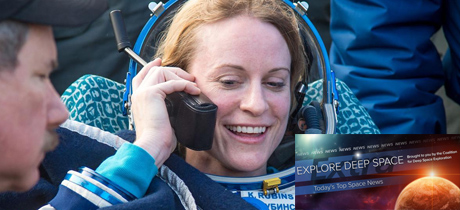In Today’s Deep Space Extra… NASA will continue to work with Russia for the launch of astronauts to the International Space Station (ISS). The Mars Insight “mole” pushes deeper into the planet’s surface.
Human Space Exploration
NASA assigns astronaut Kate Rubins to expedition 63/64 Space Station crew
Coalition Member in the News – Boeing
NASA (6/3): Veteran NASA astronaut Kate Rubins will join two cosmonauts aboard a Russian Soyuz scheduled for launch to the International Space Station (ISS) on October 14. Their six month mission will assure a continuing U.S. presence on the orbiting science lab as NASA’s Commercial Crew Program continues to work with Boeing and SpaceX to achieve certifications for regularly scheduled commercial Space Station crew transportation.
Space Science
NASA InSight lander finally pushes its burrowing ‘mole’ into Mars
CNET (6/3): NASA and its Mars Insight mission partner, the German Aerospace Center, or DLR, report new progress in getting the Insight lander’s subsurface heat probe to penetrate the surface crust at Insight’s Elysium Planitia landing site. InSight touched down on Mars in November 2018, but had difficulties early getting the Heat Flow Physical Properties Package, HP3, also referred to as “the mole,” to pound its way into the crust. The mission reports some success, using the lander’s robot arm to exert a downward force of “the mole,” which is to measure the flow of heat rising from the Martian core.
Astronomers turn back time to solve Einstein ring mystery
Space.com (6/3): Scientists from NASA’s Jet Propulsion Laboratory (JPL) and the United Kingdom have combined efforts to sift back through observations made with NASA’s Chandra X-ray Observatory to reassess gravitational lensing observations of a ring of light traced to a distant quasar first observed in 1987 with the Very Large Array, a group of ground-based radio telescopes in New Mexico. They were able to determine the bright quasar is 10 billion light years from Earth. The findings were published in the astrophysical journal Letters.
The history and future of telescopes on the Moon
Astronomy.com (6/3): The Moon’s far side holds the promise of offering an interference free realm for radio telescopes to study the distant universe. NASA’s Apollo 16 astronauts included an ultraviolet telescope on their mission to the Moon in 1972 to assess the lunar surface for astronomy. China followed suit in 2013 with a robotic mission.
Other News
Astrobotic awarded NASA contract to develop UltraNav smart camera for next-gen space missions
Coalition Member in the News — Astrobotic Technology, Inc.
Parabolicarc.com (6/3): NASA has selected Astrobotic, of Pittsburg, to continue the development of UltraNav, an autonomous visual navigation system for missions that range from the servicing of Earth orbiting satellites to landing spacecraft at the poles of the Moon or on the mountains of Mars. NASA is funding the continuing development with a $750,000, two-year grant that is part of the agency’s Small Business Innovative Research initiative.
GAO flags concerns about procurement of DoD’s early warning satellites
SpaceNews.com (6/3): In a new report, the U.S. General Accountability Office (GAO), the audit arm of Congress, warns that plans by the new U.S. Space Force to launch five new missile warning satellites by 2029 are progressing well but there could be risks. Two concerns were identified, meeting ground support requirements and sensor integration within each of the satellites.
SpaceX launches eighth Starlink mission, first VisorSat satellite
SpaceNews.com (6/3): SpaceX launched another collection of 60 Starlink internet connectivity satellites late Wednesday from Cape Canaveral Air Force Station, Florida. One of the satellites was equipped with a prototype visor designed to reduce the reflectivity of small satellites in a fleet anticipated to eventually number in the thousands. The astronomy community has expressed concerns that the brightness of the satellites is interfering with observations. The first stage of the Falcon 9 rocket was recovered by a drone ship after what was its fifth launch.

